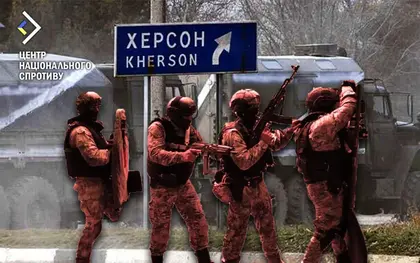Around 35,000 Russian troops from the Russian National Guard (Rosgvardia) have been deployed in the temporarily occupied territories of Ukraine, according to partisan spokespersons quoted by the National Resistance Center of Ukraine (CNR).
The Rosgvardia is a military formation directly subordinate to president Vladimir Putin and currently makes up the second largest element of his forces in the occupied areas of Ukraine after the Russian Armed Forces.
JOIN US ON TELEGRAM
Follow our coverage of the war on the @Kyivpost_official.
The main duties of the Rosgvardia are to detect partisans in the occupied territories, filter the local population and to conduct propaganda activities in educational institutions. They also constantly patrol areas within occupied cities in armored combat vehicles and in full gear in an ongoing display of aggression and power.
According to the CNR, half of the Rosgvardia manpower deployed to Ukraine are regular formations, which are divided into a brigade, 5 battalion tactical groups, and 44 tactical groups. The rest, more than 100 consolidated units, have been formed from detachments of the Special Purpose Police Detachment (OMON) and the Special Rapid Response Unit (SOBR) from mainland Russia that rotate regularly.
Rosgvardia troops deployed in the occupied territories are equipped with tanks, armored vehicles, helicopters and artillery systems, in addition to more conventional service transport. According to Ukrainian partisans, the occupying forces use this considerable weaponry to suppress and subdue any sign of dissent against Russian authority among the local population.

ISW Russian Offensive Campaign Assessment, January 10, 2025
“This is exactly how their ‘grandfathers’ [who served] in the ranks of the People's Commissariat of Internal Affairs of the USSR acted when Soviet troops occupied Western Ukraine and the Baltic countries after 1945,” a CNR representative said.
Rosgvardia forces were also involved in guarding polling stations in the occupied territories during the sham September 2022 referendum and the pseudo-elections of September 2023. Partisans also anticipate that Rosgvardia troops will exert pressure on the population during the forthcoming March Russian presidential elections.
“These units are responsible for the preservation of Putin’s ruling regime and his entourage on the territory of the Russian Federation itself, it can be argued that Putin’s Rosgvardia is the Russian analogue of the Gestapo from the times of the Third Reich,” CNR said.
However, this has not prevented Ukrainian partisans from obstructing elections in the occupied territories. Local residents in the occupied areas resisted pseudo-elections and attempted to disrupt the voting.
This resistance varied from distributing leaflets urging local residents to ignore the elections to providing information about those involved in running the elections to the Main Intelligence Directorate of the Ministry of Defense (HUR).
“Some of the names of collaborators and traitors, as well as the invaders involved in the organization of these pseudo-elections, have been established, and some have already been liquidated. Further work is underway,” Andriy Yusov, a representative of HUR said.
He added that the actions of such local activists is “greatly helping the Ukrainian security and defense forces.”
Even before the start of the elections, Ukraine’s resistance forces discovered that the Russian military was transporting election materials and ballots and provided targeting information that allowed a Ukrainian kamikaze drone to intercept and disrupt the activity.
You can also highlight the text and press Ctrl + Enter






